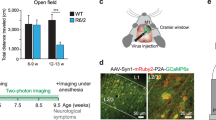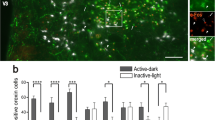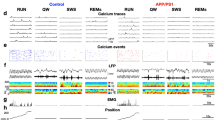Abstract
Huntington’s disease (HD) is an inherited and progressive neurodegenerative disease associated with the pathology of basal ganglia mediating memory for motor response and attributes. Hallmark chorea and motor disturbances are often preceded by cognitive and psychiatric symptoms associated with neuronal dysfunction, rather than cell death, of the vulnerable neural circuits. The exact nature of the neural functions altered in the disease, in particular, the information coding process mediating cognitive and behavioral disturbances, is unknown.
A few recent studies have attempted to elucidate this issue by performing electrophysiological recordings of single-unit and population neural activity in awake and behaving transgenic mice used to model HD. These investigations revealed dramatic and unique alterations in electrophysiological activity in basal ganglia circuitry over different brain activity states, i.e., task acquisition, exploration of environment, and sleep. These alterations took the form of a reduced recruitment of striatal projection neurons during behaviors as well as aberrant oscillatory activities in a wide range of frequencies in the cortico-striatal circuit. The aberrant rhythmic activities in θ, β, and γ frequencies were differently expressed according to brain activation levels and vigilance states. These neural functional modifications may collectively contribute to the cognitive and behavioral abnormities observed in HD transgenic mice.
Access this chapter
Tax calculation will be finalised at checkout
Purchases are for personal use only
Similar content being viewed by others
References
Andre, V. M., Cepeda, C., & Levine, M. S. (2010). Dopamine and glutamate in Huntington’s disease: A balancing act. CNS Neuroscience & Therapeutics, 16(3), 163–178.
Andre, V. M., Fisher, Y. E., & Levine, M. S. (2011a). Altered balance of activity in the striatal direct and indirect pathways in mouse models of Huntington’s disease. Frontiers in Systems Neuroscience, 5, 46.
Andre, V. M., Cepeda, C., Fisher, Y. E., Huynh, M., Bardakjian, N., & Singh, S. (2011b). Differential electrophysiological changes in striatal output neurons in Huntington's disease. The Journal of Neuroscience, 31(4), 1170–1182.
Arnulf, I., Nielsen, J., Lohmann, E., Schiefer, J., Wild, E., Jennum, P., Konofal, E., Walker, M., Oudiette, D., Tabrizi, S., Durr, A. (2008). Rapid eye movement sleep disturbances in Huntington disease. Archives of Neurololy, 65(4), 482–488.
Barnes, T. D., Kubota, Y., Hu, D., Jin, D. Z., & Graybiel, A. M. (2005). Activity of striatal neurons reflects dynamic encoding and recoding of procedural memories. Nature, 437(7062), 1158–1161.
Bassil, F., Du, Z., Garret, M., Mons, N., & Cho, Y. H. (2012). Altered basal ganglion activity in the R6/1 mice. Society for Neuroscience Abstract.
Berke, J. D. (2008). Uncoordinated firing rate changes of striatal fast-spiking interneurons during behavioral task performance. The Journal of Neuroscience, 28(40), 10075–10080.
Berke, J. D., Okatan, M., Skurski, J., & Eichenbaum, H. B. (2004). Oscillatory entrainment of striatal neurons in freely moving rats. Neuron, 43(6), 883–896.
Brooks, S. P., Betteridge, H., Trueman, R. C., Jones, L., & Dunnett, S. B. (2006). Selective extra-dimensional set shifting deficit in a knock-in mouse model of Huntington’s disease. Brain Research Bulletin, 69(4), 452–457.
Cayzac, S., Delcasso, S., Paz, V., Jeantet, Y., & Cho, Y. H. (2011). Changes in striatal procedural memory coding correlate with learning deficits in a mouse model of Huntington disease. Proceedings of the National Academy of Sciences of the United States of America, 108(22), 9280–9285.
Cepeda, C., Hurst, R. S., Calvert, C. R., Hernandez-Echeagaray, E., Nguyen, O. K., & Jocoy, E. (2003). Transient and progressive electrophysiological alterations in the corticostriatal pathway in a mouse model of Huntington’s disease. The Journal of Neuroscience, 23(3), 961–969.
Cepeda, C., Wu, N., Andre, V. M., Cummings, D. M., & Levine, M. S. (2007). The corticostriatal pathway in Huntington’s disease. Progress in Neurobiology, 81(5–6), 253–271.
Cha, J. H. (2007). Transcriptional signatures in Huntington’s disease. Progress in Neurobiology, 83(4), 228–248.
Cha, J. H., Frey, A. S., Alsdorf, S. A., Kerner, J. A., Kosinski, C. M., & Mangiarini, L. (1999). Altered neurotransmitter receptor expression in transgenic mouse models of Huntington’s disease. Philosophical Transactions of the Royal Society of London. Series B, Biological Sciences, 354(1386), 981–989.
Chen, J. Y., Wang, E. A., Cepeda, C., & Levine, M. S. (2013). Dopamine imbalance in Huntington’s disease: A mechanism for the lack of behavioral flexibility. Frontiers in Neurosciences, 7, 114.
Cho, Y. H., & Jeantet, Y. (2010). Differential involvement of prefrontal cortex, striatum, and hippocampus in DRL performance in mice. Neurobiology of Learning and Memory, 93(1), 85–91.
Cummings, D. M., Milnerwood, A. J., Dallerac, G. M., Waights, V., Brown, J. Y., & Vatsavayai, S. C. (2006). Aberrant cortical synaptic plasticity and dopaminergic dysfunction in a mouse model of Huntington’s disease. Human Molecular Genetics, 15(19), 2856–2868.
Cummings, D. M., Milnerwood, A. J., Dallerac, G. M., Vatsavayai, S. C., Hirst, M. C., & Murphy, K. P. (2007). Abnormal cortical synaptic plasticity in a mouse model of Huntington’s disease. Brain Research Bulletin, 72(2/3), 103–107.
Cybulska-Klosowicz, A., Mazarakis, N. K., Van Dellen, A., Blakemore, C., Hannan, A. J., & Kossut, M. (2004). Impaired learning-dependent cortical plasticity in Huntington’s disease transgenic mice. Neurobiology of Diseases, 17(3), 427–434.
DiFiglia, M., Sapp, E., Chase, K., Schwarz, C., Meloni, A., & Young, C. (1995). Huntingtin is a cytoplasmic protein associated with vesicles in human and rat brain neurons. Neuron, 14(5), 1075–1081.
Dumas, E. M., van den Bogaard, S. J., Middelkoop, H. A., & Roos, R. A. (2013). A review of cognition in Huntington’s disease. Frontiers in Bioscience (Scholar Edition), 5, 1–18.
Ermis, U., Krakow, K., Voss, U. (2010). Arousal thresholds during human tonic and phasic REM sleep. Jounal of Sleep Research, 19(3), 400–406.
Ferrante, R. J. (2009). Mouse models of Huntington’s disease and methodological considerations for therapeutic trials. Biochimica et Biophysica Acta, 1792(6), 506–520.
Fries, P. (2005). A mechanism for cognitive dynamics: Neuronal communication through neuronal coherence. Trends in Cognitive Sciences, 9(10), 474–480.
Gage, G. J., Stoetzner, C. R., Wiltschko, A. B., & Berke, J. D. (2010). Selective activation of striatal fast-spiking interneurons during choice execution. Neuron, 67(3), 466–479.
Gerfen, C. R., Engber, T. M., Mahan, L. C., Susel, Z., Chase, T. N., & Monsma, F. J. Jr. (1990). D1 and D2 dopamine receptor-regulated gene expression of striatonigral and striatopallidal neurons. Science, 250(4986), 1429–1432.
Graybiel, A. M., Aosaki, T., Flaherty, A. W., & Kimura, M. (1994). The basal ganglia and adaptive motor control. Science, 265(5180), 1826–1831.
Grote, H. E., Bull, N. D., Howard, M. L., van Dellen, A., Blakemore, C., & Bartlett, P. F. (2005). Cognitive disorders and neurogenesis deficits in Huntington’s disease mice are rescued by fluoxetine. The European Journal of Neuroscience, 22(8), 2081–2088.
Gutekunst, C. A., Li, S. H., Yi, H., Mulroy, J. S., Kuemmerle, S., & Jones, R. (1999). Nuclear and neuropil aggregates in Huntington’s disease: Relationship to neuropathology. The Journal of Neuroscience, 19(7), 2522–2534.
Howes, O., Bose, S., Turkheimer, F., Valli, I., Egerton, A., & Stahl, D. (2011). Progressive increase in striatal dopamine synthesis capacity as patients develop psychosis: A PET study. Molecular Psychiatry, 16(9), 885–886.
Jakel, R. J., & Maragos, W. F. (2000). Neuronal cell death in Huntington’s disease: A potential role for dopamine. Trends in Neurosciences, 23(6), 239–245.
Jeantet, Y., Cayzac, S., & Cho, Y. H. (2013). Beta oscillation during slow wave sleep and rapid eye movement sleep in the electroencephalogram of a transgenic mouse model of Huntington’s disease. PLoS One, 8(11), e79509.
Jog, M. S., Kubota, Y., Connolly, C. I., Hillegaart, V., & Graybiel, A. M. (1999). Building neural representations of habits. Science, 286(5445), 1745–1749.
Josiassen, R. C., Curry, L. M., & Mancall, E. L. (1983). Development of neuropsychological deficits in Huntington’s disease. Archives of Neurology, 40(13), 791–796.
Kesner, R. P., & Rogers, J. (2004). An analysis of independence and interactions of brain substrates that subserve multiple attributes, memory systems, and underlying processes. Neurobiology of Learning and Memory, 82(3), 199–215.
Lawrence, A. D., Sahakian, B. J., Hodges, J. R., Rosser, A. E., Lange, K. W., & Robbins, T. W. (1996). Executive and mnemonic functions in early Huntington’s disease. Brain, 119(Pt 5), 1633–1645.
Lawrence, A. D., Watkins, L. H., Sahakian, B. J., Hodges, J. R., & Robbins, T. W. (2000). Visual object and visuospatial cognition in Huntington’s disease: Implications for information processing in corticostriatal circuits. Brain, 123(Pt 7), 1349–1364.
Le Moine, C., & Bloch, B. (1995). D1 and D2 dopamine receptor gene expression in the rat striatum: Sensitive cRNA probes demonstrate prominent segregation of D1 and D2 mRNAs in distinct neuronal populations of the dorsal and ventral striatum. The Journal of Comparative Neurology, 355(3), 418–426.
Lebreton, F., Cayzac, S., Pietropaolo, S., Jeantet, Y., Cho, Y. H. (2015). Sleep physiology alterations precede plethoric phenotypic changes in R6/1 Huntington’s disease mice, Plos One, i0(5), e0126972.
Lemiere, J., Decruyenaere, M., Evers-Kiebooms, G., Vandenbussche, E., & Dom, R. (2004). Cognitive changes in patients with Huntington’s disease (HD) and asymptomatic carriers of the HD mutation—a longitudinal follow-up study. Journal of Neurology, 251(8), 935–942.
Leventhal, L., Sortwell, C. E., Hanbury, R., Collier, T. J., Kordower, J. H., & Palfi, S. (2000). Cyclosporin A protects striatal neurons in vitro and in vivo from 3-nitropropionic acid toxicity. The Journal of Comparative Neurology, 425(4), 471–478.
Lione, L. A., Carter, R. J., Hunt, M. J., Bates, G. P., Morton, A. J., & Dunnett, S. B. (1999). Selective discrimination learning impairments in mice expressing the human Huntington’s disease mutation. The Journal of Neuroscience, 19(23), 10428–10437.
Mallet, N., Le Moine, C., Charpier, S., & Gonon, F. (2005). Feedforward inhibition of projection neurons by fast-spiking GABA interneurons in the rat striatum in vivo. The Journal of Neuroscience, 25(15), 3857–3869.
Mangiarini, L., Sathasivam, K., Seller, M., Cozens, B., Harper, A., & Hetherington, C. (1996). Exon 1 of the HD gene with an expanded CAG repeat is sufficient to cause a progressive neurological phenotype in transgenic mice. Cell, 87(3), 493–506.
Marshall, L., & Born, J. (2007). The contribution of sleep to hippocampus-dependent memory consolidation. Trends in Cognitive Sciences, 11(10), 442–450.
Matamales, M., Bertran-Gonzalez, J., Salomon, L., Degos, B., Deniau, J. M., & Valjent, E. (2009). Striatal medium-sized spiny neurons: Identification by nuclear staining and study of neuronal subpopulations in BAC transgenic mice. PLoS One, 4(3), e4770.
Morton, A. J., Wood, N. I., Hastings, M. H., Hurelbrink, C., Barker, R. A., & Maywood, E. S. (2005). Disintegration of the sleep-wake cycle and circadian timing in Huntington’s disease. The Journal of Neuroscience, 25(1), 157–163.
Naver, B., Stub, C., Moller, M., Fenger, K., Hansen, A. K., & Hasholt, L. (2003). Molecular and behavioral analysis of the R6/1 Huntington’s disease transgenic mouse. Neuroscience, 122(4), 1049–1057.
Nicniocaill, B., Haraldsson, B., Hansson, O., O’Connor, W. T., & Brundin, P. (2001). Altered striatal amino acid neurotransmitter release monitored using microdialysis in R6/1 Huntington transgenic mice. The European Journal of Neuroscience, 13(1), 206–210.
Nithianantharajah, J., Barkus, C., Murphy, M., & Hannan, A. J. (2008). Gene-environment interactions modulating cognitive function and molecular correlates of synaptic plasticity in Huntington's disease transgenic mice. Neurobiology of Diseases, 29(3), 490–504.
Pang, T. Y., Du, X., Zajac, M. S., Howard, M. L., & Hannan, A. J. (2009). Altered serotonin receptor expression is associated with depression-related behavior in the R6/1 transgenic mouse model of Huntington’s disease. Human Molecular Genetics, 18(4), 753–766.
Petersen, A., Puschban, Z., Lotharius, J., NicNiocaill, B., Wiekop, P., & O’Connor, W. T. (2002). Evidence for dysfunction of the nigrostriatal pathway in the R6/1 line of transgenic Huntington’s disease mice. Neurobiology of Diseases, 11(1), 134–146.
Petersen, A., Gil, J., Maat-Schieman, M. L., Bjorkqvist, M., Tanila, H., Araújo, I. M., Smith, R., Popovic, N., Wierup, N., Norlén, P., Li, J. Y., Roos, R. A., Sundler, F., Mulder, H., Brundin, P. (2005). Orexin loss in Huntington’s disease. Human Molecular Genetics, 14(1), 39–47.
Pietropaolo, S., Delage, P., Cayzac, S., Crusio, W. E., & Cho, Y. H. (2011). Sex-dependent changes in social behaviors in motor pre-symptomatic R6/1 mice. PLoS One, 6(5), e19965.
Reiner, A., Albin, R. L., Anderson, K. D., D’Amato, C. J., Penney, J. B., & Young, A. B. (1988). Differential loss of striatal projection neurons in Huntington disease. Proceedings of the National Academy of Sciences of the United States of America, 85(15), 5733–5737.
Singer, W. (1999). Neuronal synchrony: A versatile code for the definition of relations? Neuron, 24(1), 49–65, 111–125.
Squire, L. R. (1992). Memory and the hippocampus: A synthesis from findings with rats, monkeys, and humans. Psychological Review, 99(2), 195–231.
Stalnaker, T. A., Calhoon, G. G., Ogawa, M., Roesch, M. R., & Schoenbaum, G. (2010). Neural correlates of stimulus-response and response-outcome associations in dorsolateral versus dorsomedial striatum. Frontiers in Integrative Neuroscience, 4, 12.
Starr, P. A., Kang, G. A., Heath, S., Shimamoto, S., & Turner, R. S. (2008). Pallidal neuronal discharge in Huntington’s disease: Support for selective loss of striatal cells originating the indirect pathway. Experimental Neurology, 211(1), 227–233.
Tang, J. K., Moro, E., Lozano, A. M., Lang, A. E., Hutchison, W. D., & Mahant, N. (2005). Firing rates of pallidal neurons are similar in Huntington’s and Parkinson’s disease patients. Experimental Brain Research, 166(2), 230–236.
The Huntington’s Disease Collaborative Research Group (1993). A novel gene containing a trinucleotide repeat that is expanded and unstable on Huntington’s disease chromosomes. The Huntington’s disease collaborative research group. Cell, 72(6), 971–983.
Vonsattel, J. P., Myers, R. H., Stevens, T. J., Ferrante, R. J., Bird, E. D., & Richardson, E. P. Jr. (1985). Neuropathological classification of Huntington’s disease. Journal of Neuropathology and Experimental Neurology, 44(6), 559–577.
Voorn, P., Vanderschuren, L. J., Groenewegen, H. J., Robbins, T. W., & Pennartz, C. M. (2004). Putting a spin on the dorsal-ventral divide of the striatum. Trends Neuroscience, 27(8), 468–474.
Walker, M. P., & Stickgold, R. (2004). Sleep-dependent learning and memory consolidation. Neuron, 44(1), 121–133.
Wiegand, M., Moller, A. A., Lauer, C. J., Stolz, S., Schreiber, W., Dose, M., Krieg, J. C. (1991). Nocturnal sleep in Huntington’s disease. Journal of Neurology, 238(4), 203–208.
Yin, H. H., & Knowlton, B. J. (2006). The role of the basal ganglia in habit formation. Nature Reviews. Neuroscience, 7(6), 464–476.
Acknowledgment
The works summarized here were supported by the Hereditary Disease Foundation, the University of Bordeaux 1, the HD Society of America, and the Agence Nationale de la Recherche (ANR-08-MNPS-019-01).
The authors wish to thank Vietminh Paz, Sebastien Delcasso, Sebastien Cayzac, Susanna Pietropaolo, Pauline Delage, Fanny Lebreton, Michele Pignatelli, Xavier Leinekugel, Fares Bassil, Nicole Mons, Huowei Du, Maurice Garret, Magali Cabanas for their fruitful collaborations.
Author information
Authors and Affiliations
Corresponding author
Editor information
Editors and Affiliations
Rights and permissions
Copyright information
© 2016 Springer International Publishing Switzerland
About this chapter
Cite this chapter
Cho, Y., Jeantet, Y. (2016). Altered Neural Synchronies Underlying Cognitive Deficits in a Transgenic Mouse Model of Huntington’s Disease. In: Jackson, P., Chiba, A., Berman, R., Ragozzino, M. (eds) The Neurobiological Basis of Memory. Springer, Cham. https://doi.org/10.1007/978-3-319-15759-7_14
Download citation
DOI: https://doi.org/10.1007/978-3-319-15759-7_14
Published:
Publisher Name: Springer, Cham
Print ISBN: 978-3-319-15758-0
Online ISBN: 978-3-319-15759-7
eBook Packages: Behavioral Science and PsychologyBehavioral Science and Psychology (R0)




